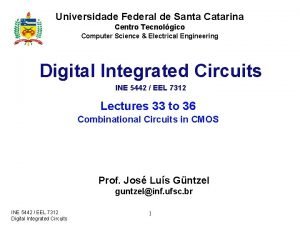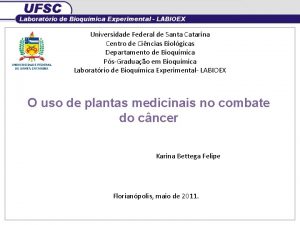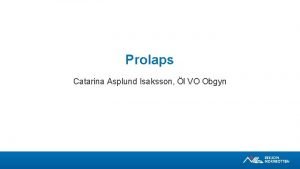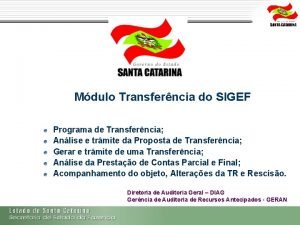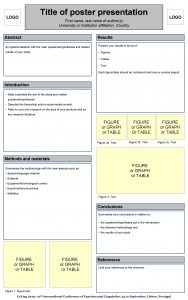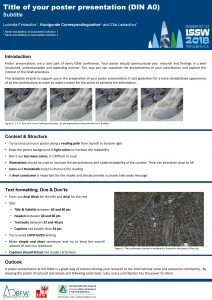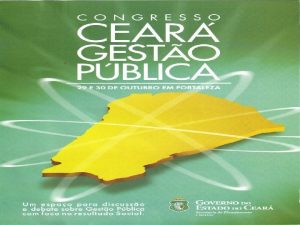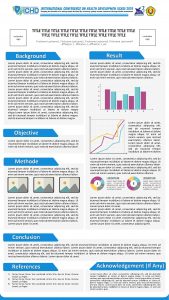Title of the Presentation Catarina Melim 1 Ivana




















- Slides: 20

Title of the Presentation Catarina Melim 1, Ivana Jarak 1 , Elisiário Tavares da Silva 1, 3, 4, Fernanda Roleira 1, 3, 4, Francisco Veiga 1, 2 and Ana Figueiras 1, 2, * Univ. Coimbra, Faculty of Pharmacy, Polo das Ciências da Saúde, Azinhaga de Santa Comba, 3000 -548, Coimbra, Portugal Univ. Coimbra, REQUIMTE/LAQ, Group of Pharmaceutical Technology, Faculty of Pharmacy, Polo das Ciências da Saúde, Azinhaga de Santa Comba, 3000 -548, Portugal 3 Univ. Coimbra, Laboratory of Pharmaceutical Chemistry, Faculty of Pharmacy, Polo das Ciências da Saúde, Azinhaga de Santa Comba, 3000 -548, Coimbra, Portugal 4 Univ. Coimbra, CIEPQPF, Centre for Chemical Processes Engineering and Forest Products, Coimbra, Portugal * Correspondence: rfigueiras@ff. uc. pt; Telef : +351 239 488 400 1 2 1

Abstract Osteosarcoma (OS) is a rare, aggressive bone tumor that impacts mostly children and young adults. Despite numerous therapeutic efforts, OS still presents low patient survival rate, high metastasis, and relapse occurrence. To surpass that, polymeric micelles have been researched for the targeted co-delivery of genetic material and drugs. In this work, mixed polymeric micelles with cationic properties containing polyethyleneimine (PEI), Pluronics® F 68 and P 123 were prepared. Pluronic® F 68 was activated by addition of diacrylate groups and conjugated with PEI. Pluronic® P 123 was incorporated in the formulation in a ratio of 2: 1 regarding the concentration of Pluronic® F 68 -PEI and Pluronic® P 123. The nanosystems were structurally characterized by FTIR and NMR spectroscopy and the morphology was assessed by TEM. Particle size, polydispersity index (PDI) and zeta potential were assessed by Dynamic and Electrophoretic Light Scattering, respectively. Small-sized, irregularly shaped F 68 -PEI micelles were obtained, with a PDI of 0. 346 and zeta potential of 12. 59 m. V. Incorporating Pluronic® P 123 in the formulation lowered particle size and resulted in spherical micelles. Zeta potential decreased due the presence of Pluronic® P 123, but remained positive. These results indicate a stable, small-sized nanosystem, characteristics that suggest a capability to surpass multidrug resistance and perform active targeting towards OS. Keywords: Osteosarcoma; Pluronic F 68; Pluronic P 123; Polyethyleneimine; Polymeric Micelle. 2

Osteosarcoma Rare bone disease, high incidence rate in children/young adults; Prognosis practically unchanged. . . Low patient survival rate Worse scenario in younger patients High disease relapse occurrence 3

Osteosarcoma Challenges to treatment Multiple Drug Resistance Most common feature in patients suffering from metastatic OS More aggressive tumor form or type 4

Osteosarcoma Challenges to treatment Active targeting Lack of therapeutic agents capable of specific antitumor activity Drug concentration is lowered to avoid cytotoxicity to normal cells New therapeutic options are needed! 5

Nanomedicine Nano-sized materials for therapeutic and imaging purposes Nanosystems researched against cancer include… Liposomes, metallic nanoparticles, solid lipid nanoparticles, dendrimers, albumin nanoparticles, and polymeric micelles. Core-shell nanostructures between 10 -200 nm, composed of a hydrophilic and a hydrophobic segment 6

Nanomedicine Nano-sized materials for therapeutic and imaging purposes Polymeric Micelles Advantageous characteristics • Small size allows for tissue penetration and passive tumor targeting; • Avoids the RES system and recognition by macrophages, resulting in a higher blood circulation time; • Higher drug load capacity; • Benefit from EPR effect; • Outer hydrophilic block can be tailored by adding ligands. 7

Nanomedicine Nano-sized materials for therapeutic and imaging purposes Pluronics Non-ionic surfactants commonly used in PMs. They possess an amphiphilic nature, with hydrophobic PPO blocks and hydrophilic PEO blocks. 8

Cationic Polymers Frequently conjugated with PMs, as they aid nucleic acid transfection PEI Most used synthetic cationic polymer Spontaneously establishes electrostatic interactions between its protonable amino groups and the phosphate groups in the nucleic acids. High transfection efficiency in in vitro and in vivo testing. “Proton sponge” effect helps the endosomal escape. 9

Methods Synthesis of Pluronic® F 68 diacrylate acryloyl chloride triethylenamine 70ºC, 6 h hexane filtration F 68 dissolved in toluene rotavapor vacuum oven (25ºC) Pluronic® F 68 diacrylate Figure 1 | Schematic representation of the synthesis of Pluronic F 68 diacrylate 10

Methods Synthesis of Pluronic® F 68 diacrylate complexed with PEI dissolved in CH 2 Cl 2 or methanol Frozen at 80ºC 40ºC, 48 h F 68 diacrylate dissolved in CH 2 Cl 2 or methanol Dry product dissolved in H 20 PEI + Pluronic ® F 68 Lyophilizate 48 h, 4ºC Rotavapor 40ºC Figure 2 | Schematic representation of the synthesis of Pluronic F 68 diacrylate complexed with PEI 11

Results and Discussion Synthesis of Pluronic® F 68 diacrylate Figure 3 | 1 H-NMR spectra of Pluronic ® F 68 (orange) and Pluronic® F 68 diacrylate (red). Appearance of new peaks due to the incorporation of olefinic acryloyl protons, indicative of the acrylate groups end-capped in Pluronic® F 68 Slight shift in the signal of the terminal CH 2 PEO protons 12

Results and Discussion Synthesis of Pluronic® F 68 diacrylate F 68 4100 3600 3100 2600 F 68 DA 2100 1600 1100 600 Wavenumber (cm-1) Figure 4 | FTIR spectra of Pluronic® F 68 and Pluronic® F 68 diacrylate. A new bond can be detected, representative of the formation of the new ester bond 13

Results and Discussion Synthesis of Pluronic® F 68 diacrylate complexed with PEI Table 1 | Characteristics of the complex formed between Pluronic® F 68 diacrylate with PEI in dichloromethane following the lyophilization process, before and after filtration. Sample Particle Size (nm) Polydispersity Index Zeta Potential (m. V) F 68/PEI before filtration 546. 6± 44. 41 0. 549± 0. 216 -- F 68/PEI after filtration 153. 3± 45. 19 0. 346± 0. 092 12. 59± 6. 205 Note: Data are represented as mean ± SD. Reduction in particle size observed after filtration may be associated with less unbounded PEI in the solution. PDI decreased to a more favorable value, indicates a homogeneous and stable solution. The zeta potential value is still relevant, despite lower than the admitted value for a stable micelle. 14

Results and Discussion Synthesis of Pluronic® F 68 diacrylate complexed with PEI Figure 5 | 1 H-NMR spectra of PEI (orange), Pluronic® F 68 diacrylate complexed with PEI (red), and Pluronic® F 68 diacrylate (green). The peak corresponding to the CH 2 groups of PEI, and the appearance of new peaks in F 68/PEI spectrum in the same ppm zone and its absence in the diacrylate spectrum indicates a successful conjugation of F 68 with PEI 15

Results and Discussion Synthesis of Pluronic® F 68 diacrylate complexed with PEI F 68 DA 4100 3600 3100 2600 F 68 PEI 2100 1600 1100 600 Wavenumber (cm-1) Figure 6 | FTIR spectra of Pluronic® F 68 diacrylate and Pluronic® F 68 diacrylate complexed with PEI. The PEI band is identified at 3400 cm -1 (amine N-H vibrations). New band appeared at 3400 cm-1, due to the N-H bond vibration, proving the presence of the conjugated PEI in the formulation 16

Results and Discussion Synthesis of Pluronic® F 68 diacrylate complexed with PEI and Pluronic ® P 123 Table 2 | Characteristics of the complexes formed between Pluronic® F 68/PEI with the addition of Pluronic® P 123 at different ratios, after filtration. Ratios Particle Size (nm) Polydispersity Index Zeta Potential (m. V) 1: 1 83. 36± 1. 273 0. 337± 0. 033 7. 747± 1. 256 1: 2 108. 6± 7. 546 0. 437± 0. 006 3. 833± 0. 847 2: 1 119. 6± 1. 973 0. 442± 0. 019 7. 287± 2. 277 Note: Data are represented as mean ± SD. Addition of Pluronic® P 123 was able to lower the particle size, at any given ratio, to below 200 nm, and even when compared with the F 68/PEI particle size measurement after filtration. Lower concentrations of Pluronic® P 123, in the 1: 1 and 2: 1 ratios, led to a higher value of zeta potential. 17

Results and Discussion Synthesis of Pluronic® F 68 diacrylate complexed with PEI and Pluronic ® P 123 500 nm Figure 7 | TEM image of Pluronic®F 68/PEI + Pluronic® P 123 (2: 1) with measurements of particle size. Nanoparticle size is similar to mean results obtained through DLS, indicating the sample is uniform and presented low aggregation. The particles were spherical and presented a darker center and a lighter shell. The latter could be due to the hydrophilic chains of PEI. 18

Conclusions Pluronic® F 68 diacrylate was synthesized and characterized by 1 H-NMR and FTIR spectroscopy. The complexation of PEI with the diacrylate was performed and the particle size measurements were favorable (20 -200 nm), but a slightly high PDI and a low zeta potential was obtained. The incorporation of Pluronic® P 123, at different ratios, to the Pluronic® F 68 reaction with PEI did ameliorate the polydispersity index and originated smaller particles, but zeta potential remained lower than favorable. TEM results showed nanoparticles with a micellar structure and in the presence of PEI, a lighter hydrophilic shell was observed. 19

Acknowledgments 20
 Catarina frade
Catarina frade Universidade federal de santa catarina brazil
Universidade federal de santa catarina brazil Ielsc
Ielsc Colegio registral de santa catarina
Colegio registral de santa catarina Universidade federal de santa catarina
Universidade federal de santa catarina Universidade federal de santa catarina
Universidade federal de santa catarina Universidade federal de santa catarina
Universidade federal de santa catarina Siare ufsc
Siare ufsc Biblivre
Biblivre Catarina asplund isaksson
Catarina asplund isaksson Secretaria do estado de santa catarina
Secretaria do estado de santa catarina Havan santa catarina br 101
Havan santa catarina br 101 Title fly of a report
Title fly of a report Title title
Title title Poster presentation title
Poster presentation title Insert the sub title of your presentation
Insert the sub title of your presentation This is your presentation title
This is your presentation title This is your presentation title
This is your presentation title Poster presentation logo
Poster presentation logo Poster presentation title
Poster presentation title Transition headline
Transition headline






